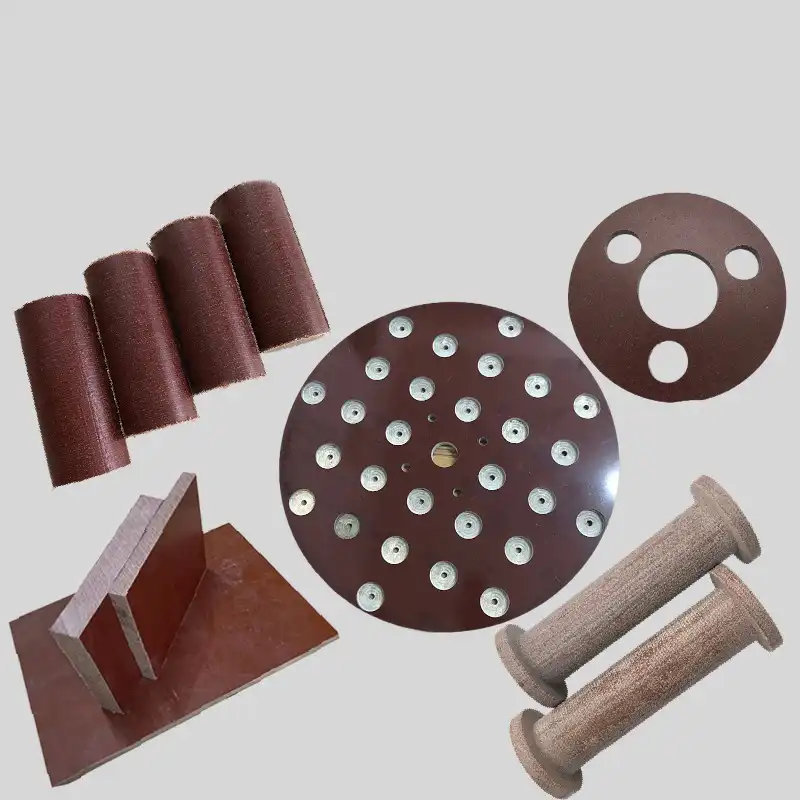Understanding Phenolic Cotton Sheets
Composition and Manufacturing Process
Phenolic cotton sheets are a composite material that merges natural cotton fibers with synthetic phenolic resins. The manufacturing process begins with the careful selection of high-quality cotton fibers, which are then impregnated with phenolic resins. This impregnation process ensures that the resin penetrates deeply into the cotton structure, creating a uniform and robust material. The sheets are then subjected to heat and pressure, causing the resin to cure and bond with the cotton fibers. This results in a material that exhibits exceptional thermal insulation properties while maintaining structural strength.
Physical Properties and Characteristics
The unique composition of phenolic cotton sheets, also known as phenolic cotton cloth board, endows them with a remarkable set of physical properties. These sheets boast low thermal conductivity, typically ranging from 0.06 to 0.08 W/mK, making them highly effective insulators. They also demonstrate excellent dimensional stability, even under varying temperature conditions. The material's density can be tailored during manufacturing to suit specific application requirements, usually falling between 1.0 to 1.4 g/cm³. Additionally, phenolic cotton sheets exhibit good machinability, allowing for easy customization and integration into various systems.
Advantages Over Other Insulating Materials
Phenolic cotton sheets offer several advantages over traditional insulating materials. Their superior thermal resistance, coupled with low weight, makes them an attractive option for applications where both insulation and weight reduction are critical. Unlike some synthetic insulators, phenolic cotton sheets are environmentally friendly and do not emit harmful gases during use. They also demonstrate excellent fire resistance and low smoke emission, enhancing safety in high-temperature environments. Furthermore, their ability to withstand mechanical stress without compromising insulation performance sets them apart from many alternative materials.
Applications in Heat Management
Industrial Equipment and Machinery
In the realm of industrial equipment and machinery, phenolic cotton sheets have found widespread application. They are extensively used in the insulation of boilers, furnaces, and heat exchangers, where maintaining thermal efficiency is paramount. The sheets' ability to withstand high temperatures while providing excellent insulation helps in reducing energy losses and improving overall system performance. In machinery that generates significant heat during operation, such as turbines and compressors, phenolic cotton sheets serve as effective thermal barriers, protecting surrounding components and maintaining operational stability.
Aerospace and Aviation
The aerospace industry has embraced phenolic cotton sheets for their exceptional thermal management capabilities in extreme conditions. These materials are utilized in aircraft and spacecraft insulation, where they help maintain cabin temperatures and protect sensitive electronic equipment from the harsh thermal environment of high-altitude and space travel. The lightweight nature of phenolic cotton sheets is particularly advantageous in aerospace applications, contributing to fuel efficiency without compromising on insulation performance. Their fire-resistant properties also enhance safety in these critical applications.
Building and Construction
In the building and construction sector, phenolic cotton sheets have gained traction as an effective insulation solution. They are employed in wall and roof insulation, helping to reduce heat transfer between the interior and exterior of buildings. This application not only enhances energy efficiency but also contributes to maintaining comfortable indoor temperatures. The sheets' fire-resistant properties make them particularly suitable for use in structures where fire safety is a primary concern. Additionally, their sound-dampening characteristics offer the added benefit of noise reduction in buildings.
Optimizing Thermal Conductivity
Factors Affecting Thermal Performance
Several factors influence the thermal performance of phenolic cotton sheets, also known as phenolic cotton cloth board. The density of the material plays a significant role, with higher density typically resulting in lower thermal conductivity. The moisture content of the sheets can also affect their insulating properties, as water has a higher thermal conductivity than air. Environmental conditions, such as ambient temperature and humidity, can impact the sheets' performance over time. The thickness of the insulation layer is another crucial factor, with thicker sheets generally providing better insulation. Understanding these factors is essential for optimizing the use of phenolic cotton sheets in various heat management applications.
Customization for Specific Applications
One of the strengths of phenolic cotton sheets is their adaptability to specific application requirements. Manufacturers can adjust the density, thickness, and resin content of the sheets to achieve desired thermal conductivity values. For applications requiring extreme temperature resistance, specialized phenolic resins can be incorporated. Surface treatments can be applied to enhance moisture resistance or improve bonding with other materials. This customization capability allows engineers to fine-tune the thermal properties of phenolic cotton sheets, ensuring optimal performance in diverse heat management scenarios.
Innovative Developments and Future Trends
The field of phenolic cotton sheet technology continues to evolve, with ongoing research focused on enhancing their thermal management capabilities. Recent innovations include the incorporation of nanomaterials to further reduce thermal conductivity and improve fire resistance. There's also a growing trend towards developing bio-based phenolic resins, aligning with the increasing demand for sustainable materials. Future developments may explore hybrid composites, combining phenolic cotton with other high-performance materials to create insulation solutions with even more advanced properties. As the demand for efficient heat management solutions grows across industries, phenolic cotton sheets are poised to play an increasingly important role in thermal engineering.
Conclusion
Phenolic cotton sheets have proven to be a versatile and efficient solution for thermal conductivity management across various industries. Their unique combination of natural and synthetic materials offers superior insulation properties, fire resistance, and customizability. As thermal management continues to be a critical concern in industrial, aerospace, and construction applications, the role of phenolic cotton sheets is likely to expand. With ongoing research and development, these materials are set to become even more effective in meeting the evolving challenges of heat management in diverse technological landscapes.
Contact Us
Are you looking for high-quality phenolic cotton sheets for your heat management needs? Contact us today at info@jhd-material.com for expert advice and customized solutions. Let us help you optimize your thermal management systems with our premium insulating materials.






